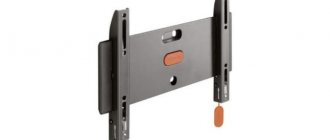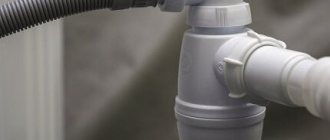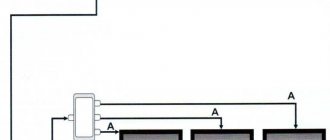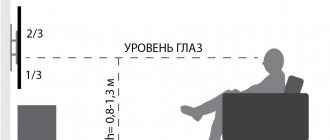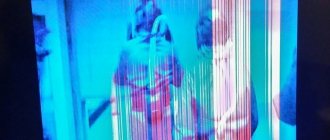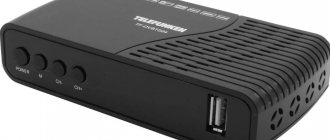Home House and cottage Repair
Almost every family has a television, and some of them have two or more televisions. Each person has it for one purpose or another, but most often it is needed for a pleasant time with loved ones, and is very popular among friends. Modern youth are not even interested in watching any regular channels on it, because they prefer to watch their TV series on it from the Internet or watch various videos on YouTube; modern TVs are also widely used for various games on XBOX.
Since the TV can be mounted in any part of the room, its position is determined according to the individual preferences of the person who wants to place his brand new TV in a place convenient for him. This place is selected for each interior separately.
No one has yet come up with restrictions on the specific location and fixation of the TV on the wall, so it can be hung absolutely anywhere in the room. But they consider it a rule to hang modern televisions at a level of at least 1 meter from the floor, and also so that the tap is at eye level.
To fix your TV, you can call a specialist in this service or fix it yourself. In order to do this yourself, you need to have basic knowledge of precise measurements, as well as know how to attach screws to the wall. Hanging a TV is not a hard job and can be completed in a couple of hours. You shouldn’t do this yourself, because it will be better if someone supports the TV while attaching it to the bracket.
Preparing for installation - 3 main rules
In order to properly hang a TV, you must adhere to three main rules:
- Study the characteristics of the equipment in detail. Directly to install any type of TV, you need to know its diagonal, weight and type of TV. This information must be in the documentation of the purchased equipment. If your device weighs more than 25 kilograms, then installation must be done by two people.
- We determine the type of wall on which the equipment will be installed. It is usually made of wood, brick, concrete or made of plasterboard. At the same time, the selection of tools, brackets, fasteners and fittings that will be needed directly for installation is made.
- Find out the location of the electrical wiring on this wall. This will help us better hide wires and cables, and also not disturb the overall electrical wiring system.
The main advantages and disadvantages of a wall-mounted TV
Let's start with the good, namely the advantages. Manufacturers of modern TVs help us with this. They are working to make our TV screen as compact as possible. This allows us to save space, which will make our interior more spacious. And the flat screen will be the highlight of our interior; it will perfectly decorate the wall, and absolutely, it doesn’t matter whether your interior has a retro style or a modern one.
Also, an additional advantage is that modern equipment is more resistant to mechanical damage. Therefore, if your TV falls on the floor, there are many chances that it will remain in working order.
Now we can talk about the shortcomings.
There are 3 main disadvantages of a wall-mounted TV (during installation):
- If it falls, for example due to a loose bracket, your TV may fall completely out of position.
- Hanging a TV on the wall is more difficult than simply placing it on a table or cabinet, so you will need the help of another person, especially if the entire diagonal of the TV is quite large.
- It is strictly prohibited to mount a TV weighing more than 35 kilograms on weak walls (plasterboard), as well as above heating devices.
Despite the disadvantages of a wall-mounted TV, it is very popular and quite easy to install if you follow the basic rules for its installation.
Choosing a place for the TV
To watch a TV installed in a constant position comfortably, you should choose the most correct installation location for it. When choosing, you should take into account the type of your device, the size of its diagonal, and the way in which television channels are broadcast on it.
One of the most important installation rules is to place the device at eye level. Viewing with your head up or down is extremely inconvenient. Experts have developed special tables containing basic recommendations regarding the choice of distance from the television screen to the viewer’s location.
- Before hanging the TV on the wall, you need to evaluate the chosen location for its suitability for your purposes:
- Check whether the wiring runs along the selected wall and how it runs - this is necessary so that in the process of preparing holes for the bolts you do not accidentally touch it.
- See if there is a socket in the access area of the television cable - the closer it is to the device, the easier it is to hide the wires that go to it.
It is highly recommended not to choose niches and recesses for installation - the device will be poorly ventilated in them and, as a result, will heat up more. For these purposes, you need to stay in open space.
Types of fasteners
Wall mount, the same bracket, is a special mount that is used to mount a modern TV to a selected wall. There are 4 types of fasteners in total, their main difference is that each of them can adjust the position of the screen in its own way, thereby increasing the comfort of watching TV.
Before you buy a bracket, you need to be sure that it will fit your TV model. To do this, you need to ask what standard the bracket is and compare it with the standard for mounting our modern TV.
Let's take a look at 4 famous wall fasteners.
Rigid fastener
A rigid low-profile mount is a mount that attaches your TV 10-20 centimeters from the wall. The rigid fastener does not have an adjustment function, that is, after installation, with its help we will not be able to turn or tilt the TV. For this type of mounting, we recommend hanging your TV at head level for ease of viewing various programs and TV series.
The advantages of this type are low price, safety, and ease of installation.
The disadvantages include several factors. There is no position adjustment, as well as difficult access to the TV connectors that are located behind it.
Inclined fastener
With this mount, you can change the angle of your TV, install it at your eye level, thereby adding to the comfort of watching TV. The distance from the wall to the bracket is up to 15 centimeters. The angle of inclination varies between different brackets, but generally it is in the range of 10-25 degrees.
The advantages of this type are its affordable price, simplicity of design, and most importantly, it allows you to adjust the tilt of your TV.
The only disadvantage of this type is the lack of rotation of the TV.
Swivel fastener
This mount is unique because it can be used to move, rotate or tilt the TV as you see fit. This bracket is quite expensive, but it is worth it. Yes, it has restrictions on the size and weight of your TV, this can be found in the documentation of a specific bracket model, but we are confident that you can choose a good and fairly productive bracket at an inexpensive price.
The advantages include ease of use and beautiful appearance.
The disadvantages include the expensive cost of the bracket, as well as the difficulty in installing this fastener.
Ceiling fastener
This mount is quite popular in various offices and establishments, as it is convenient to provide advertising to visitors and colleagues. It allows the TV to rotate 360 degrees and also allows the screen to tilt. To use them you must have high ceilings.
I think everything is clear about the advantages, but the disadvantages include difficulty in installation, as well as in supplying the cable, which, most likely, will be easier to run under the ceiling than to the floor.
Methods for mounting a TV on the wall
The wall area allows you to choose a place to install the screen on a larger scale than the floor space. However, first you need to decide how the equipment will be mounted on the wall. There are two main options you can use.
Equipment surrounded by furniture
If the wall is already occupied by pieces of furniture - a set or cabinets, choosing a place to install the TV is a little more difficult than if there is an empty wall. There are two possible options for this:
- Install fixedly in one place. The TV cannot be rotated or tilted with this installation method, so it is worth considering how convenient it will be to watch programs from different corners of the room, and whether cabinets and other interior elements will interfere with the view.
- Use a retractable bracket as fastening. This option allows you to move the TV forward if necessary and stow it away when not on. In small apartments where you need to fit a lot of equipment and furniture in a small space, this will be the best solution. In this case, there is no need to pay attention to the surrounding furniture - you can always change the position of the screen.
Extendable brackets have restrictions on the maximum load weight. Therefore, large screens with a diagonal exceeding 32 inches can only be installed after determining the maximum possible load on the bracket. Manufacturers set it in kilograms. At the same time, to protect expensive equipment, it is worth playing it safe and reducing the maximum load set by the seller by 10%. In the case of Chinese manufacturers, it is better to immediately reduce it by 20%.
Equipment on a bare wall
With this installation option, there is no need to adapt to the surrounding furniture and think for a long time about how to hang the TV. You can safely choose the most convenient location and any method of fastening. There will still be a small nuance: the bracket will be clearly visible from the side. To do this, you should take care that it has an aesthetic appearance and does not spoil the surrounding interior. In this case, it is better not to use homemade equipment.
Limitation of mounting a TV on a wall without using a bracket
We list these restrictions in the following list:
- It is allowed to install only thin TVs such as LCD, LED and Plazma
- On your TV, all connectors should be exclusively on the sides
- The installation height should be no more than 1.5 meters;
- After installation, it is very difficult to move the TV;
- The opposite wall must be covered.
If you are going on a wall that is based on brick, then you can safely proceed with installation. But here we will give you some useful tips:
- The TV should be hung so that it is at eye level, naturally, when you are in a sitting position.
- The distance from the TV to your eyes should be equal to the diagonal of the TV multiplied by 3.
- There is no need to calculate the length of the bolts, since each set with the TV comes with bolts of a certain length. They should be used.
- On the opposite side, it is necessary to mount a plate (iron) about 5 cm higher and wider beyond the distance between the holes when mounting on the back of the TV.
Restrictions when installing a TV without a bracket
A mounting method without using a bracket can be implemented if the TV is viewed in one direction. In this case, there is no need to select an angle of inclination or rotation for comfortable viewing, so wall mounting is considered the optimal solution.
Mounting the monitor without using a bracket is possible for certain types of displays. LCD and plasma flat panels are suitable for blind mounting. All others require a frame with a shelf or a stationary TV stand.
Before mounting, it is necessary to analyze whether the wall can support the weight of the TV. If it is made of lightweight material, such as drywall, then it is not worth the risk. Concrete, brick, and cinder block structures are considered reliable supports.
Attention! The documentation for the TV should indicate that it can be wall-mounted.
As a rule, panels with a large diagonal are attached only with brackets designed for heavy weight. In models designed for mounting, connectors and cords are located on the sides and on the front panel. Otherwise, when attached tightly to the surface, it will become impossible to use the connectors located at the back. There should be holes for screws on the back of the display case.
How to hang a TV on the wall - step-by-step hanging instructions
To make it easier for you to navigate the installation, we have provided step-by-step instructions for it. Now you can easily carry out installation.
Step 1. First, you need to choose the height of the TV. In order to do this, we sit down at the TV viewing point and select the most convenient viewing area for vision.
Step 2. You should mark the proposed TV diagram on the wall. For this we need a building level, a tape measure and a pencil. We look at our mount and mark points on the wall (as in the photo below). Don’t forget to check the horizontality of the holes that we will have; if there is even a slight distortion, this could threaten to cause the TV to fall. Therefore, we take this matter seriously.
Step 3: For this step we will need a drill. We will use it to drill holes at the indicated points.
Step 4. Using a hammer, drive the dowels into the holes, then carefully fix the brackets on the wall. Be careful with plasterboard walls, only take on this task when you are sure that your plasterboard will support your device.
Step 5. After installing the bracket, prepare the TV. Carefully insert it into the guides or tighten the bolts without much effort.
Step 6. Connect the TV to the power supply and start watching. We advise you to hide all the wires in a plastic cable so that the interior of your room is in perfect order and there are no wires in it. We can move the sockets behind the screen, using this method we will hide our wires
Now you are familiar with the instructions for mounting the TV on the wall. Watch the video to complete the entire sequence and learn a couple of nuances.
Before attaching the plate to the wall, you need to find out what material the wall is. If it is plasterboard or wood, we use special dowels, and if it is a concrete wall, then it is necessary to use dowels directly for the concrete.
Step-by-step instructions for hanging a TV on the wall
Before you start work, make sure that there are no wiring, pipes, etc. in the place where you are going to mount the bracket. If such subtleties are unknown to you, this can be done using a special detector. If everything is in order, determine the height at which the TV will hang, and then get to work.
What you will need to mount the TV on a purchased bracket:
- building level;
- a simple pencil;
- roulette;
- drill;
- dowels;
- hammer.
After unpacking the bracket, ensure that all parts are as listed in the installation instructions. The set may not be complete. If screws / dowels / self-tapping screws / washers or other components are not enough, purchase what you need.
General instructions for mounting a TV on a wall:
- Attach the bracket plate to the wall and mark each hole. Make sure that the points on the wall are strictly parallel; even a slight misalignment can cause the TV to fall.
- Drill holes with a drill at the previously marked points.
- Hammer the dowels into the holes and attach the bracket to the wall.
- Install the counter plate on the back of the TV. It must be attached to the holes already present on the back panel. They usually have fasteners that need to be unscrewed and used during the installation process. If there is none, buy the fasteners yourself, based on the size of the holes.
- After installing the bracket, carefully hang the TV on the guides or lightly tighten the bolts (depending on what type of bracket you purchased).
Detailed video instructions:
FAQ
In this section we will talk to you about the questions that people ask when they are planning to hang a TV on the wall. These questions, as well as the answers to them, are very useful for those people who are going to mount their TV on the wall.
What diagonal size is most suitable for mounting a TV on a wall?
Most people think about it and are going to buy plasmas for the floor of the wall, but before you do this, you should know whether the parameters of the room will allow you to place such large screens that your health will not deteriorate. After all, you can still buy a TV with a large diagonal, but we must think about our health.
A distance that is comfortable for vision is equal to 3-4 screen diagonals. In other words, if you have a 40-inch screen, then you should watch it from at least 3 meters away. Since 120 inches is approximately equal to 3 meters.
Many TV fans dream of a large plasma on half the wall. Buying such a TV is not difficult, but before you do it, check to what extent the parameters of your room will allow you to watch such a monitor without harm to your health.
Quite a lot of people do not take this rule into account, and thereby spoil their eyesight, and in a very short time. We ask you not to repeat their mistakes and adhere to this rule.
Hang a TV on the wall without a wall bracket: step by step
Possible installation methods are usually indicated in the instructions. Before installation, you must make sure that the purchased TV can be hung without using a bracket.
Mounting methods depend on the size of the TV. The easiest way to hang a TV is with a diagonal of less than 24 inches. If there are screw slots on the back panel, you will need to secure the mounting screws or self-tapping screws, which are often included, into the wall. The panel hangs like a framed photo. This method can only be used if it is permitted by the instructions for the TV.
Reference! A tight fit to the wall limits the possibility of ventilation, which leads to overheating of the equipment.
To ensure ventilation, a support mount is used. To hang a TV without a bracket, you can use a diagram using metal corners:
Step 1. Purchase perforated all-metal corners, metal plates, bolts, and nuts from a hardware store.
Step 2. From metal plates 4 mm thick, make a frame the size of the TV. Drill holes for the bolt slots on the back wall of the panel. The diameter of the holes depends on the thread diameter of the bolts.
Step 3. Using bolts, attach 4 corners to the frame. Fix the resulting structure on the back panel of the TV also using bolts. Check the secure fastening.
Step 4. Attach 4 corners to the wall, strictly observing the distances between the corners fixed on the back panel.
Step 5. Attach the panel to the wall, select a position. Standard metal corners have three ready-made holes that allow you to select the desired position.
Step 6. Fasten the corners with bolts and nuts.
Important! It is necessary to pay special attention to the secure fastening of all elements to prevent the TV from falling.
What should be the height between the floor and the TV?
The height is determined only by where you will place your TV, the main thing is that it is comfortable for you to watch it. It won’t be convenient for you to lift your head and watch TV from under your forehead. For example, if you are going to hang your TV in the kitchen, then in principle you can hang it from the ceiling, but on the sofa it will most likely be uncomfortable to look at the ceiling in the evenings.
In fact, there are no standards, so there is no reason. Sit in the place where you want to watch TV and choose a place for the TV on the wall.
How to hang a TV on a plasterboard wall
All of the above installation methods were designed for a solid wall. But what to do if you decide to hang the TV on the partition? It can be plasterboard, plywood, gypsum, it’s not that important. Another significant thing is that the wall simply cannot withstand a load of 10...40 kg. It will crumble at the attachment points.
This will happen if you use ordinary screws or dowels. However, a special “butterfly” dowel, also known as “molly,” has been developed specifically for installation on thin structures. The video shows the principle of its operation.
The peculiarity is that this model distributes the load over a large area. Accordingly, the wall does not crumble and can easily support the weight of the TV.
As an option, when covering a main wall with plasterboard (for leveling, sound insulation, decoration and other purposes), you can use a stud screw.
It is screwed into the main wall, passing right through the plasterboard slab. The deeper such a screw goes into a reliable structure, the greater the load it will withstand.
If you need to hang the TV on a plasterboard wall, behind which there is no base, it is better to find the places where the mounting profile is located and attach it to it. You can also add a wooden (fibre) board or similar material (board, timber, etc.) to the structure. This option is especially good for installing a TV in a niche.
Where is the best place to hide cables and wires from the TV?
This question is quite popular, especially for those people who have already hung their TV on the wall. And it is much more difficult for them to hide the wires than for those who were interested in this issue at the beginning of mounting the TV on the wall.
So, if you are currently renovating, then you need to arrange sockets directly for the TV. This will require 1 TV socket and at least 3 sockets behind the screen. We will connect the TV, Wi-Fi, and also the tuner to these sockets. The best method is to hide all these sockets directly behind the TV, this is very convenient and very popular.
But if there is a cabinet under your TV that will have other equipment, then it is better to take care and make a couple more sockets in advance, even behind the same cabinet.
We recommend placing about 5 sockets at a distance of 30 centimeters from the floor, and even if you think that you won’t need them, you are deeply mistaken. After all, now technology is developing very quickly, and no one knows what else they will come up with for the TV in 3 years, but sockets will always be needed, and you won’t need to use carriers. After all, carrying items reduces the beauty of any interior.
If the repair has already been done, then the best way would be to hide all the wires in a box cable and connect it beautifully to the TV so that it does not bother anyone, and is especially not conspicuous. An excellent way out of the situation would be if you design this cable box to match the style of your wall. After all, it is on it that he can hang quite unnoticed; in other words, it can be called a camouflaged box.
But if your TV is located near a window, then the best way to hide the wires is to use curtains with an electric curtain rod. Make a socket right under the ceiling, near the place where the curtain will be. And this will be a great discreet method to hide your wires. You can ask a curtain specialist or an electrician for more details.
How to hang a TV on the wall - 5 best tips from professionals
We advise you to familiarize yourself with this section; after reading it, you will learn how to make sure that your equipment serves you for a very long time. And also how to prevent the TV from falling off the wall. Be sure to keep these tips in mind when mounting your TV on the wall:
- Before purchasing a bracket, you need to check the weight and diagonal that it can support.
- Although the swivel mount is very popular and convenient, we advise you to use only a fixed mount. After all, only with it you can be as sure as possible that your TV will not fall to the floor.
- Recently, it has become very popular to install a TV in a plaster niche. But be careful, because air circulation, which will heat up and over time overheat the case, can become an expensive failure. Therefore, be extremely careful with this type of installation.
- A good method for securing your TV is a small homemade stand made from drywall. It can be done in a short time, but in turn, safety will increase significantly. We kindly ask you not to place the screen over the fireplace or other types of heat release. The TV is negatively affected by the radiated heat and may quickly malfunction. And the saddest thing is that no one will return your money for this, because this is stated in the documentation of every modern TV.
- Before connecting cables from the TV, securely mount the TV to the wall. Only then start connecting the wires. And keep in mind that if you have a rotating bracket, then you must make sure that there is enough wire to rotate the screen; there should be no tension at all. The distance from the viewing area directly to the screen should be from 3 to 4 diagonal sizes. Namely from 2 to 4 meters.
In fact, hanging a TV on the wall is a responsible undertaking. You just need to make a little effort and the TV will look worthy in your interior and will also perfectly decorate your wall.
After reading the article, you have learned how to properly hang a TV on the wall, we wish you success!
Installing a TV on the wall
After purchasing the bracket, all you have to do is install it on the wall and attach the TV to it. To do this, you can contact a specialist or do the installation yourself. To install it yourself, you will need the following tools:
- Hammer.
- A drill bit for a hammer drill with a diameter suitable for dowel screws.
- Screwdriver Set.
- Level.
- Yardstick.
- Pencil.
After making sure that you have all the tools and fasteners, do the following:
- Using a pencil, level and tape measure, mark the holes for the dowel screws. Be sure to check the level position of the marks in relation to each other, because even a slight misalignment of the bracket can, over time, lead to the TV falling.
- Drill holes using a hammer drill.
- Place the main part of the bracket on the wall and screw it with dowel screws.
- Install the bracket guides onto the TV using a screwdriver and bolts.
- Place the TV with the guides installed on it in the grooves on the main part of the bracket. There are models of non-separable brackets. In this case, the entire bracket is installed on the TV, and the entire structure is placed on dowels. If the TV is large, this installation process is best done with a partner.
- Connect the power cord and TV cable to the TV.
Work with a partner
As you can see, the process of installing a TV is simple, but depending on the material from which the walls are made, it may be necessary to use a different mounting method:
Dowel “butterfly”
- Walls made of plasterboard. Installation can become significantly more complicated if you are planning to hang the TV on a partition made of plasterboard. With this installation option, you will have to find the internal metal profile of the partition and attach the bracket to it using butterfly dowels.
Screw for fastening
- Wooden walls. Wood is slightly inferior in strength to brick or concrete, but to attach the bracket to a wooden wall, it is better to use simple long self-tapping screws instead of dowels. For a plywood wall, you can also use butterfly dowels.
Through-hole bolts
- Walls made of fragile materials. If your house is built of plaster, wood concrete or low-quality cinder block, then in this case, install the bracket using through fasteners. For through fastening, a hole is made through the wall and instead of dowel screws, bolts with nuts and wide washers are used.
How to hang a TV on the wall, see also in the video:
